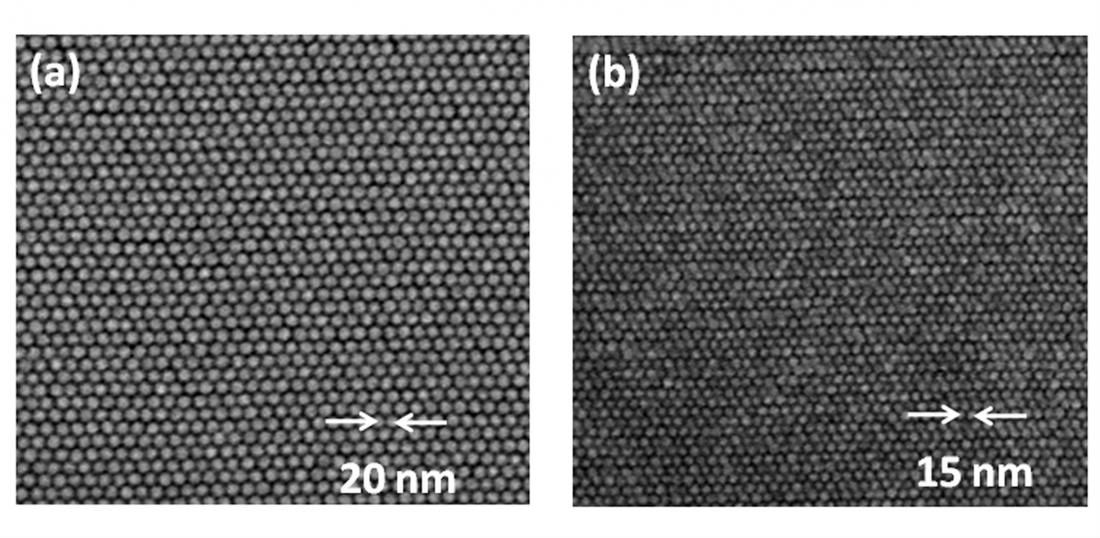Scanning electron microscopy images of magnetic bits at densities of (a) 1.9 Terabit/in2 and (b) 3.3 Terabit/in2 formed after depositing Co/Pd multilayers onto resist structures.
Singapore, 14 October 2011 – It’s like packing your clothes in your suitcase when you travel. The neater you pack them the more you can carry. In the same way, the team of scientists has used nanopatterning to closely pack more of the miniature structures that hold information in the form of bits, per unit area. Dr Joel Yang’s IMRE research team, working with peers from A*STAR’s DSI and NUS, has used nanopatterning to create uniform arrays of magnetic bits that can potentially store up to 3.3 Terabit/in2 of information, six times the recording density of current devices. This means that a hard disk drive that holds 1 Terabyte (TB) of data today could, in the future, hold 6 TB of information in the same size using this new technology.
Conventional hard disks have randomly distributed nanoscopic magnetic grains - with a few tens of grains used to form one bit – that enable the latest hard disk models to hold up to 0.5 Terabit/in2 of information. The IMRE-led team used the bit-patterned media approach, where magnetic islands are patterned in a regular fashion, with each single island able to store one bit of information.
“What we have shown is that bits can be patterned more densely together by reducing the number of processing steps”, said Dr Joel Yang, the IMRE scientist who heads the project. Current technology uses very tiny ‘grains’ of about 7-8 nm in size deposited on the surface of storage media. However, information or a single bit, is stored in a cluster of these ‘grains’ and not in any single ‘grain’. IMRE’s bits are about 10nm in size but store information in a single structure.
The method has been demonstrated to achieve data-storage capability at 1.9 Terabit/in2, though bits of up to 3.3 Terabit/in2 densities were fabricated. “In addition to making the bits, we demonstrated that they can be used to store data,” explained Dr Yang.
The secret of the research lies in the use of an extremely high-resolution e-beam lithography process that produces super fine nano-sized structures. Dr Yang discovered that by adding sodium chloride to a developer solution used in existing lithography processes, he was able to produce highly defined nanostructures down to 4.5 nm half pitch, without the need for expensive equipment upgrades. This ‘salty developer solution’ method was invented by Dr Yang when he was a graduate student at the Massachusetts Institute of Technology.
This work is the result of a collaborative effort with Prof Vivian Ng’s group at NUS, and Dr Yunjie Chen, Dr Siang Huei Leong, and Mr Tianli Huang from A*STAR DSI’s 10 Terabit/in2 Magnetic Recording programme. The researchers are now looking at increasing the storage density further.
For media enquiries, please contact:
Mr Eugene Low
Manager, Corporate Communications
for Institute of Materials Research and Engineering (IMRE)
3, Research Link
Singapore 117602
DID +65 6874 8491
Mobile +65 9230 9235
Email [email protected]
Ms Melissa Koh
Senior Officer, Corporate Communications
for Data Storage Institute (DSI)
5 Engineering Drive 1
(Off Kent Ridge Crescent, NUS)
Singapore 117608
DID +65 6874 6852
Email [email protected]
For technical enquiries, please contact:
Dr Joel Yang
Scientist I
Institute of Materials Research and Engineering (IMRE)
3, Research Link
Singapore 117602
DID +65 6874 8385
Email [email protected]



